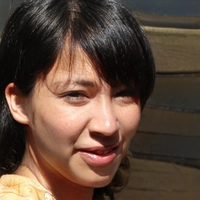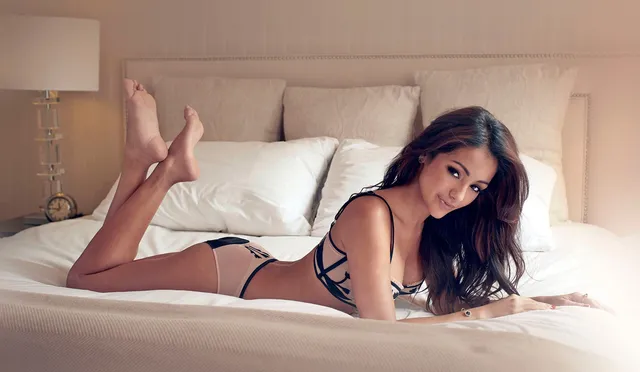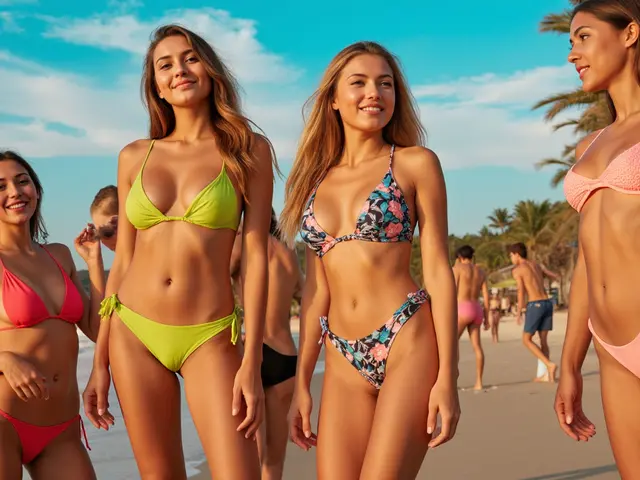The Faces That Changed Everything: Why Supermodels Matter
If you flip through any vintage Vogue, it’s almost like staring into history. You’ll see faces that aren’t just beautiful—they’re instantly recognizable. Naomi Campbell’s cool confidence, Cindy Crawford’s smirk, Linda Evangelista’s ever-changing look… these supermodels didn’t just wear fashion, they defined it. They set trends, starred in music videos, dated rock stars, and had Barbie dolls made in their likeness. Honestly, can you name anyone who hasn’t heard of Kate Moss? There’s a reason people still try to copy her grunge look after all these years.
Supermodels aren’t just clothes hangers. They’re cultural touchstones. That sharp bone structure? It started entire beauty crazes. A bold walk down the runway? That’s now a move copied in TikTok challenges worldwide. There’s also something wild about how their journeys often began. Naomi got discovered while shopping, Gisele was spotted at a fast-food joint, and Kate Moss got her big break at an airport. This isn’t just about fashion—these stories are about luck, perseverance, and that spark you just can’t manufacture.
Ever notice how some faces just stick with you? There’s always chatter about how beauty standards are constantly shifting, but these supermodels forced people to redefine what “classic” and “unique” actually meant. The industry chased Claudia Schiffer’s sleek look and then pivoted hard with Alek Wek’s stunning features. When Tyra Banks became the first Black woman on the cover of Sports Illustrated’s swimsuit issue in 1997, it broke barriers. The impact went far beyond the pages of a magazine. Kids in tiny towns around the world got to see someone who looked like them land a million-dollar contract. That’s not just cool—it’s powerful.
So why should you care? These faces have launched careers, brands, and even charities. Imagine launching a makeup empire (RIP, Cindy Crawford’s Meaningful Beauty) or becoming a UN Goodwill ambassador, as Gisele Bündchen did. Their legacy isn’t only about what’s on a billboard in Times Square; it’s proof of how one photo, one unexpected grin, or one bold eyebrow arch can send ripples through the entire fashion world—and beyond.
What Makes a Supermodel’s Face Stand Out?
We always hear about “the look”—but what is it? Symmetry? A defined jawline? Something in the eyes? The truth is, there’s no single formula. Yet, every era has faces so tied to fashion you can’t picture one without the other. Let’s break it down a bit. In the ‘90s, it was all about strong features: think Cindy Crawford’s mole or Claudia Schiffer’s icy blue gaze. In the 2000s, more designers chased the unconventional: think Karen Elson’s fiery red hair or Lily Cole’s wide-set features. Meanwhile, the rise of social media brought in a fresh crew—Gigi and Bella Hadid, Kendall Jenner, and Adut Akech—who blur the lines between standard beauty and raw personality.
Intensity is a big deal. Linda Evangelista once turned down gigs unless she could change her hair—she got away with it because her eyes could shift from sweet to fierce in a single frame. Ever seen Gisele Bundchen’s walk? Her power comes from how alive she looks on the runway—no robot models here. Diversity is another part of the story. Decades ago, only a narrow set of looks was allowed onto magazine covers. That’s changing, though not nearly fast enough according to plenty of insiders. The growing popularity of models like Precious Lee, Paloma Elsesser, and Soo Joo Park shows that fashion fans crave fresh faces and real representation.
The numbers also tell an interesting story. A study by the Fashion Spot in 2023 found that about 51% of models on the runways of Paris, Milan, New York, and London Fashion Weeks were people of color—that’s double what it was just a decade ago. Social media’s also turned supermodels into household names. Having millions of Instagram followers makes it easier for models to connect with fans and brands, which just wasn’t possible in the decades before. It means faces become familiar faster, and personality becomes part of the package.
Want a pro tip if you’re scouting for the next big face? Look for models who make you remember them before you even know their name. Tyra Banks always says smiling “with your eyes” gives a photo extra electricity—she even coined the term “smize.” Watch old show footage: the way Naomi Campbell commands a catwalk or Alek Wek’s beaming grin as she struts is proof that a little personality goes a long way.
Fashion’s Most Iconic Faces (with Fun Facts You Might Not Know!)
Here’s where things get juicy. These are the faces everyone in the industry obsesses over, with side notes to spice things up:
- Naomi Campbell – She was discovered at age 15 in London and is the only Black model of her generation to reach international supermodel status. Her walk? Legendary. She’s also known for charity work and her famous “walk-off” moments at Versace.
- Cindy Crawford – That mole above her lip? It got her teased as a kid. Now, it’s her trademark. She covered over 500 magazines in the ‘90s and even graced Pepsi commercials during the Super Bowl.
- Linda Evangelista – Famously declared, “We don’t wake up for less than $10,000 a day.” She’s the queen of reinvention—once she even shaved her eyebrows for a runway show!
- Kate Moss – She was discovered at JFK Airport, barely 14 years old. She defined ‘heroin chic’ in the 1990s and helped Calvin Klein’s brand explode worldwide.
- Gisele Bündchen – Dubbed “the Body,” she owns the record for most Vogue covers in one year. Before modeling, she wanted to play volleyball professionally.
- Claudia Schiffer – She was considered the spitting image of Brigitte Bardot as a teen. Today, she has a Barbie doll made in her likeness and even inspired characters in video games.
- Tyra Banks – First Black woman to cover both GQ and the Sports Illustrated Swimsuit Issue. She pioneered “America’s Next Top Model” and is a fierce advocate for body positivity.
- Alek Wek – Born in South Sudan, she fled civil war before getting discovered in London. Her radiant smile and short hair helped smash stereotypes about who could be a supermodel.
- Bella Hadid – While younger than the ‘90s clan, her sharp cheekbones and blue-green gaze give her a classic look that fits any era. She’s walked more than 80 runways at a single season of Fashion Week—talk about stamina!
- Adut Akech – She’s walked major runways for Valentino, Givenchy, and Chanel… all by the age of 23. A refugee from South Sudan, her story inspires a whole new wave of aspiring models.
There are plenty more—Iman, Christy Turlington, Jourdan Dunn, Liu Wen—but these are the faces that pop up in campaign after campaign. Their secret weapon? They don’t just wear fashion; they become a living, breathing part of it.
| Supermodel | Era | Signature Feature | Legacy Highlight |
|---|---|---|---|
| Naomi Campbell | 1980s - Present | Runway walk | Pioneered diversity in major campaigns |
| Cindy Crawford | 1980s - 1990s | Beauty mark | Fitness videos, businesswoman |
| Linda Evangelista | 1980s - 2000s | Shape-shifting look | $10,000/day quote, frequent reinvention |
| Kate Moss | 1990s - Present | Heroin chic look | Calvin Klein, redefining model body types |
| Gisele Bündchen | 2000s - Present | Legs, walk, smile | Most Vogue covers, environmental activism |
Ever want to spot a future legend? Look for that spark that makes a model trend on Twitter for days—usually, it’s something no one quite expects.
Behind the Iconic Image: What Else Makes a Supermodel Shine?
There’s more than just “the look.” When you dig deeper, the staying power of top models usually boils down to grit (yes, real grit) and smarts. The runway might look like all fun and glitter, but these women put in hardcore work behind the scenes. Take lessons from their routines: Naomi Campbell’s pre-show routine reportedly includes everything from turmeric shots to guided breathing exercises. Gisele even credits yoga for her stamina and mental focus in the most stressful shows.
Brands zero in on professionalism—late-night fittings, last-minute photoshoots, and grueling travel all come with the title. That’s why you see so many models launch successful brands after their fashion careers. Tyra Banks didn’t just rest on her early success—she created a TV empire and wrote about modeling tricks that help regular people boost confidence.
Something interesting: the power of social media has completely turned the industry on its head. Models with a following of a million plus get more campaigns than ever. Gigi Hadid shot a Vogue cover after fans participated in a hashtag campaign. You don’t have to camp out in New York or Milan to be a supermodel—sometimes you just need the right selfie at the right moment. Insider tip? If you want to catch the industry’s eye, start building a following by connecting with people, sharing style tips, or joining TikTok’s #ModelSearch challenges.
People always ask if supermodels get special treatment. Well, sometimes. But it’s also super competitive. Even the “faces” have rough audition stories. Linda Evangelista’s first big show, she tripped and fell. Tyra Banks got turned away by several European agencies before scoring big in Paris. If you’re thinking of modeling, know that rejection comes with the gig, but so does global travel, lasting friendships, and wild adventures you’d never find anywhere else.
So what’s the secret sauce for a supermodel? It’s a mix of unique looks, perseverance, positive energy, and the ability to hustle. Models who stand out aren’t just memorable for how they look, but also for how they make you feel. When you see Alek Wek’s joy on the runway, or Tyra Banks championing new talent, it’s unforgettable.
Tips for Standing Out (and Connecting with the Fashion World)
If you’re dreaming of entering the world of modeling—whether for fun, confidence, or a full-blown career—here are a few things you should know, straight from insiders and famous faces themselves:
- Find your signature feature and highlight it. Maybe it’s freckles, a strong brow, or a dazzling smile. Don’t try to airbrush it away.
- Your personality matters just as much as your profile. Brands want good vibes on set, not just pretty faces.
- Network like it’s your job. Go to fashion events in your city (even small ones!), connect on social media, and share your looks and story.
- Stay healthy, both mentally and physically. Legendary models like Cindy Crawford still swear by getting enough sleep, drinking water, and sneaking in fun workouts like boxing or dance classes. Don’t starve yourself or over-exercise.
- Work with photographers who help you find your unique spark. Collaborations make you stand out, plus you’ll get lots of great pics for your portfolio.
- Join casting calls—even local ones open doors! The more you show up, the more people remember you.
- Study the greats. Watch old Versace or Alexander McQueen shows (so many free on YouTube). Pay attention to how supermodels show emotion and create drama on the runway.
There’s no one path to “icon” status, but every legend started with a risk—whether it was a bold pose, a daring haircut, or simply owning what made them different. Want to dig deeper into fashion’s history? Read interviews with industry insiders and go scroll through the early archives of Vogue or Harper’s Bazaar—so many trends started with a face you probably already know.
The faces that define fashion don’t just belong to one type, body, or background. They belong to anyone who can walk into a room, light it up, and change the way the rest of us see the world—even if it’s just for a minute. So here’s to the jaw-dropping, show-stopping faces that keep fashion wild, weird, and wonderful. Who knows? The next icon could be a selfie away.




